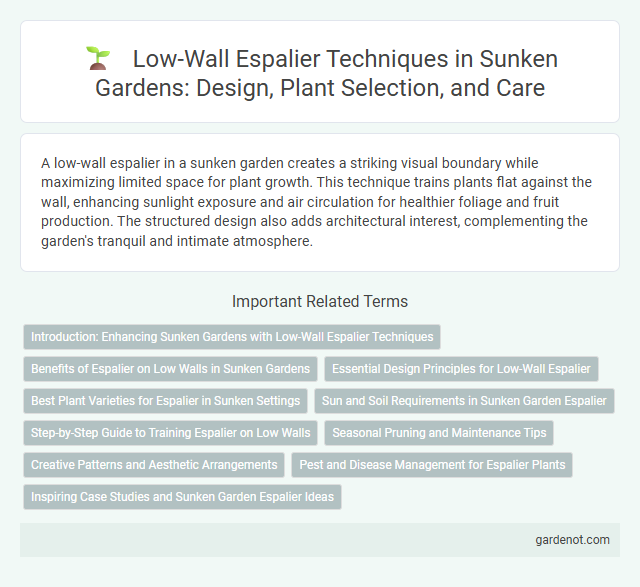A low-wall espalier in a sunken garden creates a striking visual boundary while maximizing limited space for plant growth. This technique trains plants flat against the wall, enhancing sunlight exposure and air circulation for healthier foliage and fruit production. The structured design also adds architectural interest, complementing the garden's tranquil and intimate atmosphere.
Introduction: Enhancing Sunken Gardens with Low-Wall Espalier Techniques
Low-wall espalier techniques transform sunken gardens by maximizing vertical space and creating structured, living walls that enhance aesthetic appeal and plant health. These carefully trained plants thrive against sunken garden walls, improving air circulation and sunlight exposure while adding a unique architectural element. Incorporating low-wall espalier supports diverse horticultural designs, from fruiting trees to flowering vines, boosting biodiversity and visual interest in compact garden spaces.
Benefits of Espalier on Low Walls in Sunken Gardens
Low-wall espalier in sunken gardens maximizes space by training plants to grow flat against the wall, increasing sunlight exposure and air circulation for healthier growth. This technique enhances microclimate control, reducing frost risk and promoting fruit ripening in cool, sheltered environments. Espaliered plants also create visually striking architectural elements that complement the garden's depth and structure.
Essential Design Principles for Low-Wall Espalier
Low-wall espalier design in a sunken garden emphasizes vertical plant training against compact retaining walls to maximize space and aesthetic appeal. Essential principles include selecting disease-resistant fruit trees with flexible branches, maintaining consistent pruning schedules to encourage flat, even growth, and ensuring adequate sunlight exposure for optimal photosynthesis. Proper irrigation and soil management prevent water stagnation near the wall, promoting healthy root systems and structural stability.
Best Plant Varieties for Espalier in Sunken Settings
Ideal plant varieties for low-wall espalier in sunken garden settings include apple (Malus domestica) and pear (Pyrus communis) trees, which adapt well to confined vertical spaces. Fig (Ficus carica) and quince (Cydonia oblonga) are also excellent choices due to their tolerance of microclimates created by low garden walls. These species promote healthy growth and efficient space utilization, enhancing the structure and aesthetic appeal of sunken garden walls.
Sun and Soil Requirements in Sunken Garden Espalier
Low-wall espalier in a sunken garden thrives with at least 6 hours of direct sunlight daily, supporting optimal photosynthesis and fruit development. The soil must be well-draining, rich in organic matter, and maintain a slightly acidic to neutral pH (6.0-7.0) to promote healthy root growth. Consistent moisture without waterlogging is crucial to ensure stress-free growth and disease resistance in espaliered plants exposed in sunken garden microclimates.
Step-by-Step Guide to Training Espalier on Low Walls
Training espalier on low walls requires selecting a dwarf fruit tree or climbing plant with flexible branches for easy manipulation. Start by attaching the main stem horizontally to a sturdy frame or wire fixed along the wall, securing with soft ties to avoid damage. Regular pruning encourages lateral growth along the low wall, ensuring dense foliage and maximizing sun exposure for healthy development.
Seasonal Pruning and Maintenance Tips
Seasonal pruning of low-wall espaliers in sunken gardens ensures optimal growth and fruit production by removing dead or overcrowded branches during late winter or early spring. Maintaining clean cuts and monitoring for pests each season prevent disease and enhance airflow around the espalier structure. Regular feeding with balanced fertilizers supports healthy foliage and encourages vigorous seasonal growth on these carefully trained plants.
Creative Patterns and Aesthetic Arrangements
Low-wall espalier in sunken gardens transforms vertical surfaces into dynamic living art, showcasing creative patterns that enhance spatial depth and visual interest. Arranging fruit trees or ornamental plants in symmetrical, fan, or candelabra designs maximizes sunlight exposure and emphasizes architectural aesthetics. These meticulously trained plants not only save space but also create a harmonious blend of nature and geometry, elevating the garden's overall elegance and character.
Pest and Disease Management for Espalier Plants
Effective pest and disease management for low-wall espalier plants in sunken gardens involves regular inspection for common issues such as aphids, scale insects, and fungal infections like powdery mildew. Utilizing organic insecticidal soaps and neem oil can control pests while minimizing chemical impact on the delicate espalier structure. Maintaining proper airflow through strategic pruning and ensuring well-drained soil conditions significantly reduces the risk of disease development and promotes healthy, vibrant growth.
Inspiring Case Studies and Sunken Garden Espalier Ideas
Low-wall espalier techniques in sunken garden designs maximize space while creating visually striking vertical plant displays that enhance garden aesthetics and privacy. Inspiring case studies often highlight the use of espaliered fruit trees against sunken garden walls, demonstrating improved fruit yield and microclimate control. Sunken garden espalier ideas emphasize integrating native climbers and drought-resistant plants to ensure sustainable maintenance and year-round interest.
Low-wall espalier Infographic

 gardenot.com
gardenot.com